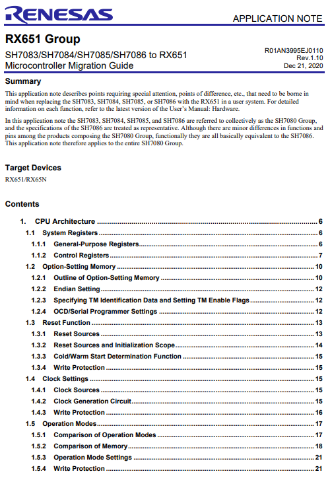The long awaiting Tokyo Olympics 2020 is behind us now and the new year of 2022 is just around the corner. Time flies and so do the changes in our world, where we are facing a major transformation point towards IoT and Cloud.
To cope with this trend, our customers have been considering the development of new products. Therefore, I would like to share some of the useful resources and documentation this time, which we think would be beneficial to those who are considering switching to RX MCU.
We have prepared a “Migration Guide” and “Points of Differences” to support replacement from Renesas legacy MCU products like SH, V850, H8S, and M16C to the RX 32-bit MCU family, as well as between MCUs in the RX family itself. The Migration Guide provides detailed explanations to frequently asked questions and precautions when porting of MCU, as well as the differences in the function between MCU. Reading it in advance really helps to give you an idea to estimate the time and cost needed and the difficulty of the migration.
Here is an example of a migration guide from the SH to RX. The comparison of each peripheral and function is explained in its respective chapter.


Below is a page about managing the interrupt flags. There is a difference in the handing of the interrupt source flag between SH and RX MCU. In the case of SH, an interrupt flag is needed to be cleared by the program. However, it is automatically cleared in the case of RX. Such kind of small yet important differences is easily overlooked when checking both the hardware manual.

Next, let’s look at the peripheral setting. Some functions such as Timers in the RX family are inherited from our legacy MCU such as SH and H8. Therefore, the functionality and registers structure are similar to the RX, making it considerably easy to migrate from one MCU to another.
Another example is the serial communication function, where you can see that the RX is completely upward compatible. However, there are some changes in the registers and the setting order, and these differences are shown in the example of the register setting procedure in the migration guide.
There are also many other examples you can find in the migration guide which are not mentioned and introduced in this blog. With this guide, it does help in your porting of the software to the new MCU.


On the other hand, when the targeted MCU doesn’t inherit the compatible peripheral, such as migration from V850, the guide offers suggestion from the viewpoint of whether there is an equivalent function. Even when there is no equivalent function, we will try to prepare an alternative method, if there is, with a software sample code for reference.
Regarding migration between the RX family, we have prepared the “Points of Differences” documents to summarize the specification differences between the under compared MCU. Similar to the “Migration Guide”, it also describes the differences of the peripherals. Although RX has many product groups, the “Points of Differences” documents covered almost all groups so that it could support migration from or to any RX MCU.
“Migration Guide” and “Points of Differences” could be downloaded from “Replacement Support Information for RX” of the RX Family Website

A PDF file showing the readiness and linkage of the “Points of Differences” document is available for quick reference as shown in the below diagram.


In the PDF, the arrow shows the targeted MCU to be migrated to and in comparison of and the number indicates the document number which can be searched under Renesas' website. Users can also simply click on this document number to open the document without searching on the website.
In addition, we have also provided various resources to support the RX development, such as precaution of the hardware design guide, automatic code generation tool, etc. Please make use of all these resources as well.
